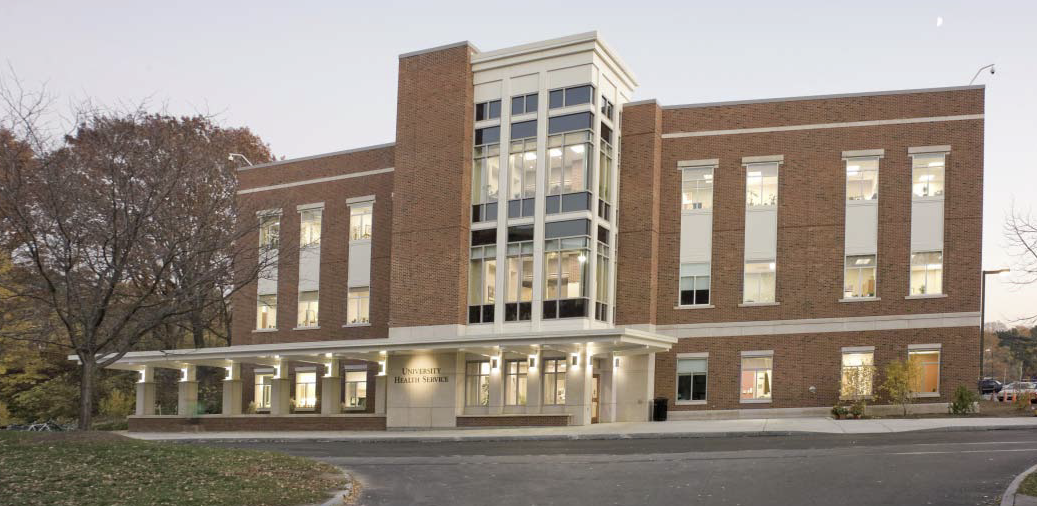
| River Campus | University Health
Service Building |
 |
| UHS Building |
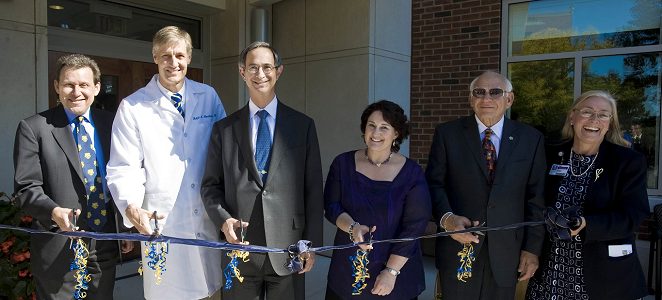 |
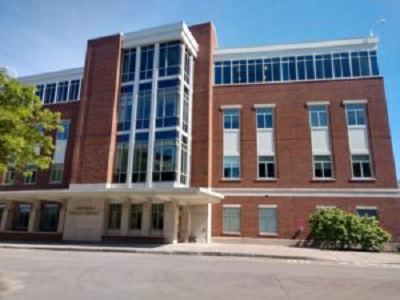 |
| Provost Ralph Kuncl, UHS Director Ralph Manchester, President Joel Seligman, Lisa Willis, director of the University Counseling Center, Trustee Roger Friedlander, and Ann McMican, associate director for administration at UHS, cut the ribbon during the grand opening of the University Health Service Building on September 18, 2008. | UHS
Building with completed 4th floor addition, July 2020 |
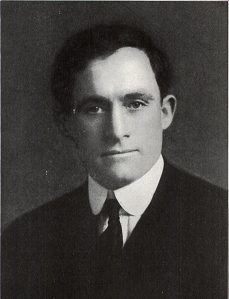 |
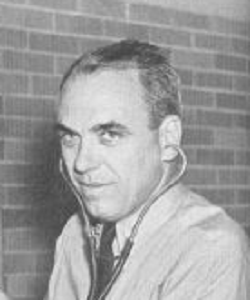 |
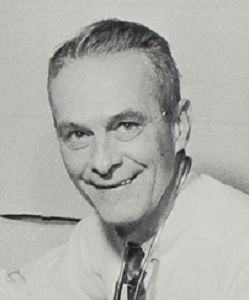 |
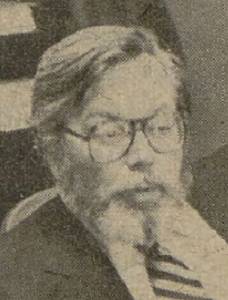 |
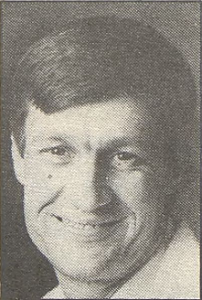 |
| Edwin Fauver |
John Fletcher McAmmond |
John H. Flinn |
Clifford Reifler |
Ralph Manchester |
The University does not appear to have had a formal student health program until Dr. Edwin Fauver was hired as professor of Hygiene and Physical Education in 1916. He was also the physician for the sports teams, and in 1921 was appointed college physician. Three earlier physical education directors had also been physicians, including John William Hobbs Pollard (1902-1905), Charles Crawford Stroud (1905-1910), and Dudley B. Reed (1910-1911).
The Alumni Gymnasium opened in 1930 and included a small space for conducting physical examinations. Munro Hall, a women's dormitory on the Prince Street Campus, opened in 1939 and included a small infirmary. In 1940 spare rooms in Burton Hall were pressed into service as an infirmary. The Navy V-12 Program on River Campus during World War II established an infirmary in Strong Memorial Hospital.
In 1955 an outpatient infirmary or clinic for men and women was installed in the Alumni Gymnasium and a small infirmary was included in the new Women's Residence Hall that opened in late 1955. The small infirmary was changed to an outpatient clinic in 1995.
The Student Health Service was established in 1962 under Dr. John H. Flinn, combining student health activities for the River Campus, Medical Center, and Eastman School of Music. A full-time psychiatrist was hired in 1963. In 1966 employee health services were combined with this organization and renamed University Health Service.
Dr. Clifford B. Reifler was appointed head of UHS in 1970 and in 1983 he also assumed the duties of medical director of Strong Memorial Hospital and senior associate dean for clinical affairs. Dr. Ralph Manchester joined UHS in 1983 and was appointed director in 1994.
In the 1970s the Psychology Department set up a Counseling and Special Services Center, which was later known as the Center for Psychological Services and then Counseling and Psychological Services. This was abolished in 1991 and UHS took over all Mental Health services on campus. Counseling and Mental Health Services changed its name to University Counseling Center in 2002.
UHS has moved many times between the River Campus and Medical Center, but these wanderings came to an end when a groundbreaking ceremony was held on May 16, 2007 for a new University Health Service Building adjacent to Susan B. Anthony Residence Hall, allowing all of its services to be delivered in one location. A fourth floor addition to the building was completed in July 2020.
UHS also operates satellite offices at the Eastman School of Music and the University of Rochester Medical Center.
References
1902 Report
of the President of the University of Rochester 1901-1902
Pages 24-25: Mr. Green, who has been director of
Physical Education for the last two years, has offered his resignation in
order that he may be free to enter upon the study of Medicine next year.
Following instructions received from you at the meeting in May, the
Executive Committee have elected as Mr. Green's successor Dr. John W. H.
Pollard, now Physical Director at Lehigh University. Dr. Pollard was
graduated with the degree B. L. from Dartmouth in 1895; he spent one year
in preparing himself specially for the work of Physical Education, and was
then for three years Physical Director at Union College, in which position
he won the high regard alike of students and faculty. While at Union, he
was in attendance on the medical college at Albany, and he resigned his
position in order to give his entire time to medical studies at the
University of Vermont. He received the degree M. D. at that institution
last June, and accepted an appointment at Lehigh for the present year. A
college graduate, a graduate in medicine, and a man of successful
experience, he comes to us to undertake our work with an equipment which
we believe promises brightly for his success. By arrangement with the
University Council, Dr. Pollard is to undertake, in conjunction with his
duties as Physical Director, the responsibilities of coach of the various
athletic teams in the College. We believe that this step is one in
advance, inasmuch as in this way a member of the Faculty will have his
hand directly upon the athletic activities of the students, and be able to
give wise counsel as well as helpful guidance and instruction. The fact
that Dr. Pollard is a physician will prove of no little advantage to our
students, inasmuch as he will hold himself ready to render aid in any case
of need which may arise in the course of the work in Athletics or in the
Gymnasium.
1906 Report
of the President of the University of Rochester 1905-1906
Pages 4-5: Director Charles Crawford Stroud, A. B., M. D., succeeded
Dr. J. W. H. Pollard as Physical Director.
Dr. Stroud came to us from Tufts College, where he had served as Physical
Director for nine years and as Medical Director for six years, and had
established a high reputation. He was graduated Bachelor of Arts at Tufts
in 1894. He then served as teacher of Classics and Physical Director at
Burr and Burton Seminary at Manchester, Vermont, for one year, and in 1895
returned to Tufts for the study of medicine, receiving his degree of
Doctor of Medicine in 1898. Dr. Stroud is employed jointly by the
University and the East High School. His mornings are given to the High
School, and his afternoons to us.
It is a pleasure to report that in all of Dr. Stroud's work he has
sympathetically co-operated with the rest of the Faculty, and has
impressed upon the students that the proper place of athletics in college
life is that of an aid to other college work. Consequently we have been
free from the effort, which is sometimes made, to secure special
dispensation from scholarly requirements for the benefit of students who
are supposed to be valuable for athletics. At no time during my connection
with the institution has the athletic life been so wholesome and so full
of good promise for the future.
1910 "Successor
to Dr. Stroud," Democrat and Chronicle, July 22, 1910, Page
19.
Dudley B. Reed, a Graduate of Oberlin, Said to Have Been Chosen to succeed
Dr. Charles C. Stroud
1911 "New
U. of C. Athletic Chief," Chicago Tribune, August 2, 1911,
Page 6.
Dr. Dudley B. Reed
1916 Report
of the President 1915-1916
Pages 11-12: Mr. Harry T. Watson, who has been with us as Physical
Director for Men since 1911, has resigned from that position and will
leave us at the close of the academic year. Mr. Watson has rendered The
University of Rochester whole-hearted and effective service in the
department of Physical Education. He has been a loyal colleague and a
tireless worker, and has earned our warmest regard and respect. He was
appointed to succeed Dr. Dudley B. Reed who left us to go to the
University of Chicago in 1911. From the outset Mr. Watson knew and loyally
accepted the fact that we believe the Physical Director should be a
graduated physician. And he has known and loyally accepted the fact that
ever since he came we have been looking for a physician who in other
respects also possesses the qualifications for an efficient professor of
Hygiene and Physical Education. Now after long waiting we have secured
such a man. Mr. Watson carries with him our affection, our respect, and
our confident expectation that he will do large things in the very
important work to which he has given his life.
The new professor of Hygiene and Physical Education, elected by you at the
May meeting of the Board, is Dr. Edwin Fauver who is now Assistant
Professor of Hygiene and Physical Education in Princeton University. Dr.
Fauver was graduated Bachelor of Arts from Oberlin College in 1899. The
year 1899–1900 he was physical director, athletic coach, and tutor in
history in Alma College, Alma, Michigan. From 1900 to 1905 he was acting
director of the gymnasium, instructor in physical education, and athletic
coach at Oberlin College. In 1905 he received the diploma of the Normal
Course in Physical Training at Oberlin. From 1905 to 1909 he was a student
of medicine at Columbia University, and received the degree M. D. from
Columbia in 1909. While studying medicine, Mr. Fauver was teacher of
gymnastics in the Horace Mann School from 1905 to 1907, and special
teacher in physical training at the Teachers' College, Columbia from 1907
to 1909. From 1909 to 1911 he was professor of hygiene and physical
education, professor of physiology and college physician at Swarthmore
College. From 1911 to the present time he has been at Princeton University
as assistant professor of hygiene and physical education.
The appointment of Dr. Fauver at the time that our new athletic field is
ready for use gives promise of a most important enlargement of our work
for more perfect health through normal and wholesome exercise.
1916 "Dr.
Edwin Fauver A Real Leader," The Campus, September 21, 1916,
Page 4.
Will be Team Physician.
1927 "Board
Defines Responsibility," The Campus, March 18, 1927, Page 3.
Expenses for outside medical attention will no the paid by the Board of
Control hereafter unless the college physician, specifically provides for
such attention, according to a ruling of the board in its last meeting.
Varsity athletes who are hors-de-combat will be taken care of at the
Medical School. Students will continue to receive the attention of Dr.
Edwin Fauver, college physician.
1927 "Infirmary Fee Made Optional," The Campus, October 7, 1927, Page 8.
1928 "Hospital
Benefits Students," The Campus, March 16, 1928, Page 8.
Sixty-seven men have received service from the Strong Memorial Hospital
from October 1 to March 1, according , to Raymond N. Ball, treasurer of
the University.
The college paid to the hospital on account of services rendered to these
men $691.00, whereas the fees collected from the students amounted to a
total of $335.00. In several instances men have received services in the
full amount of the $70.00 to which the infirmary fee entitles them.
1930 "College
Girls Healthier Lot than in the Past," Democrat and Chronicle,
January 21, 1930, Page 15.
Dr. Gertrude McCann serves in an advisory capacity. Medical work for
students at the Eastman school is under the direction of Dr. Emma Gibbons.
Dr. Edwin Fauver cares for men at the University and is college physician
and instructor in hygiene.
1931 "The
Physical Education Building at the University of Rochester," The
Research Quarterly of the American Physical Education Association
2(1):105-114 (March 1931)
Page 109: Inasmuch as Rochester has a centralized department, i.e.,
required Physical Education, Intercollegiate Athletics, and Student
Health, in one department, the plant was built to provide for ample office
space, examining rooms, and laboratory for the staff.
1931 "Dr.
McCann Joins Faculty," Alumni bulletin of the Eastman School of
Music, November 1, 1931, Page 6.
Dr. Gertrude Fischer McCann succeeds Dr. Emma C. Gibbons as medical
adviser to women at the Eastman School of Women. Dr. Gibbons
resigned her position at the Eastman School to devote more time to her
private practice.
Dr. McCann has been since 1927 medical adviser to women of the Women's
College of the University of Rochester. She now become medical
adviser to women of the University. She was graduated from Wellesley
College with the degree A.B. and from Cornell University with the degree
M.D.
1932 "Infirmary,"
The Campus, March 18, 1932, Page 6.
Fee increased to $10 yearly and will be mandatory
1939 "Jibes are Directed at Health Service," The Campus, February 17, 1939, Page 1.
1940 Report
of the President 1939-1940
Page 22: Means were fund for using some of the vacant rooms in Burton Hall
as an infirmary for those students who were ill, but not so seriously ill
as to justify being removed to the Strong Memorial Hospital. This
has resulted in better all-around care for our students, and it has also
reduced the charges against the infirmary fund. This has been
accomplished with little inconvenience and no danger to the regular
dormitory residents.
1943 "On
the Bridge: Dr. McAmmond," The Campus, October 1,
1943, Page 3.
Lieutenant Commander John F. McAmmond
1944 "Campus
Reporter Visits Hospital's Shangri-La," The Campus, March
24, 1944, Page 7.
Naval infirmary in Strong Memorial Hospital.
1945 "Infirmary
Doctor At Student Call For Ten Dollars," Tower Times,
November 14, 1945, Page 3.
Every UR and Eastman School of Music student automatically has a ten
dollar infirmary fee included in her tuition. All students stricken or
injured during the college year, and this does not mean before one enters
college or during the summer months, is eligible to apply for care at the
UR medical office, or, if in need of it to have up to eight dollars worth
of hospital care a year at Strong Memorial Hospital by the university.
It has only been since the opening of Munro in 1939 that there have been
rooms available to the students to serve as an infirmary. These rooms are
located in the left of the first floor in this building. During the 1920's
two physicians were on call for the student's use. In the latter part of
that decade, Dr. Gertrude McCann was in charge of a medical office which
was set up, and she continued until 1942. She was succeeded for the
following year by Dr. Miriam Pennoyer. Dr. Jean Watkeys, a UR and
Strong Memorial Hospital graduate came in 1943 and is the present doctor
in charge. She may be visited during the office hours which she has set
up.
Mrs. E. P. Brown has been the day nurse in charge since 1931.
Since the existence of the infirmary, there have been several night
nurses, but none so far this year. However. Miss Lillian Henderson
and Miss Lois Carroll, students for the bachelor of science in
nursing degree at the University will serve from now until June in this
capacity.
1947 "Dr. Emma C. Gibbons Dies in Portland, Me.," Democrat and Chronicle, February 19, 1947, Page 15.
1950 "The
Infirmary Welcomes All; From Colds to Counseling," Tower Times,
November 17, 1950, Page 6.
In Munro on the first floor
1953 "Why no infirmary?," Campus Times, December 18, 1953, Page 2.
1954 "Infirmary Boasts Easy Life for Music Conscious Patients," Tower Times, November 0, 1954, Page 4.
1955 "UR
Merger Adds New Facilities," Campus Times, September 20,
1955, Page 4.
Alumni Gym has been renovated to house an outpatient infirmary for men and
women. Dr. J. Fletcher McAmmond is in charge with Dr. Ruth
Gosselin. The appointment of an additional physician is now being
undertaken.
1955 "New
Women's Residence Halls Enhance Campus Life, Win Wide Admiration," Rochester
Review 17(2):6-9 (November 1955)
Page 8: In addition to the facilities mentioned, the first floor of
the Residence Halls houses the switchboard, kitchen, infirmary, the office
of the Hall's director, Miss Barbara Lewis, suites for head residents and
some student dormitories.
1955 "New
UR Infirmary Still Incomplete," Campus Times, November 15,
1955, Page 5.
The new Doctor-in-charge is Dr. Gasselyn.
1956 "On the infirmary," Campus Times, March 23, 1956, Page 4.
1956 "Dr. Gertrude Fisher McCann Dies," Democrat and Chronicle, November 16, 1956, Page 27.
1958 "Group Evaluates Infirmary Issue; Suggests Improvements, Changes," Campus Times, February 18, 1958, Page 1. | Part 2 |
1959 Bulletin
of Undergraduate Studies 1959-1960
Page 69: The health of the student body is under the
care of physicians at the Student Health Service. The outpatient
department for men and women students is housed in the medical
office in the men's gymnasium. Infirmary patients, both men and women, are
housed in the Women's Residence Halls. The infirmary is open twenty-four
hours daily for the treatment of all types of illness;
complicated cases are admitted to the University Medical Center directly
or by transfer from the infirmary on the recommendations of the student
health physicians.
1959 "UR
to Seek Nearly 50 Million To Meet Long-Term 'Challenge'," Democrat
and Chronicle, September 22, 1959, Page 1.
Student infirmary
1962 "UR
Appoints Dr. John Flinn to Unify Health Services," Campus Times,
March 6, 1962, Page 6.
One of Dr. Flinn's prime responsibilities will be to unify into a single
all-University program the health service programs conducted by Dr. J.
Fletcher McAmmond, chief medical officer for the River Campus and Eastman
School, and Dr. Einar Lie, director of student health at the Medical
Center.
1962 "Flinn Assumes Medical Duties," Campus Times, September 18, 1962, Page 7.
1962 "Flinn
Relocates Infirmary; Prepares for Flu Outbreak," Campus Times,
October 30, 1962, Page 7.
The doctor added that there are now preliminary plans for a new building
which in three years will house the medical office, infirmary, and
out-patients' ward. With Dr. Flinn as director, the new office will
unify the student health services of Eastman School, the Medical School,
Nursing School, and the River Campus.
1963 "Dr.
Flinn Believes Hepatitis Waning," Campus Times, April 23,
1963, Page 2.
Dr. John Flinn, Director of University Health Service
1963 "Health
Office Appoints Psychiatrist," Campus Times, September 20,
1963, Page 5.
Dr. Alex Braiman as a full-time psychiatrist on this campus.
1964 "Unknown
Disease Hits Dorms; Virus Infection Downs Many," Campus Times,
February 25, 1964, Page 1.
Viral gastro enteritis
1964 "Well-Equipped Health Office Offers Students Full-Time Aid," Campus Times, October 2, 1964, Page 2.
1966 "Flinn
Discusses Infirmary Plans," Campus Times, February 18, 1966,
Page 3. | Part
2 |
Dr. Flinn gave a brief outline of the development of the health service at
the UR. In the early days of the University it was a rather informal
service initiated by Dr. Fauver in the basement of the Alumni gymnasium.
1966 "Flinn Heads New
University Health Service," University Record 6(6):1 (June 1966)
In a move to improve the UR’s health program for all personnel, the
Student Health Service and Employee Health Service have been combined and
Dr. John' Flinn has been named director of the new University Health
Service.
Dr. Flinn was formerly director of Student Health Services.
Under the new plan, student and staff health services which have been
provided from three locations in the Medical Center will be provided from
a single point — R-110 — to better coordinate the services and to make
more efficient use of space and the medical staff’s time and skills.
The morning medical service for staff members in U-Ground, as well as the
pre-employment physical examinations in Q Ground (Personnel Department),
will be combined with the Student Health Service in R-110.
1966 "Dr.
Flinn to Head UR Health Unit," Democrat and Chronicle, June
24, 1966, Page 5C.
Dr. John H. Flinn, director of the Student Health Service at the
University of Rochester, has been promoted to director of the newly
consolidated University Health Service. In his new job, Dr. Flinn will
supervise and develop health services for all UR students and staff. The
University Health Service consolidates the student Health Service and
various staff health services on the university's three campuses. He will
retain his positions as associate professor of medicine in the UR School
of Medicine and Dentistry and senior associate physician at Strong
Memorial Hospital.
1967 "Health Service Lists Policies of Contraceptive Distribution," Campus Times, September 29, 1967, Page 1. | Part 2 |
1967 "Health Service Consolidate in X-Ground SMH," Currents, December 11, 1967.
1967 "Outpatient
Clinic to Move to Medical Center Saturday," Campus Times,
December 12, 1967, Page 1. | Part
2 |
The Student Health Service Outpatient clinic on the River Campus will be
moved to the ground floor of the X-wing at the University Medical center
Saturday, December 16th.
The infirmary services for inpatient care of River Campus students will
remain in the Women's Residence hall, Morgan Wing. The infirmary
will not serve ambulatory patients, except in emergency cases
In 1962 student health services on the River Campus, at the Eastman School
of Music, and at the Medical Center were administratively consolidated
under Dr. John Flinn, who was appointed director of student health
services.
In 1966, with the approval of the trustees, student and staff health
services were consolidated under Dr. Flinn, who was appointed director of
university Health Services.
1968 "Director Discusses Health Service Plan," Campus Times, February 13, 1968, Page 8.
1989 Bulletin
of Undergraduate Studies 1968-69
Page 36: The health of the student body is under the care of the
physicians of the University Health Services. The out-patient department
for all students is in the medical office located on the ground floor of X
Wing in the Medical Center. Infirmary facilities for both men and
women are located on campus, first floor of Morgan Wing in the
Women's Residence Halls. The infirmary is staffed by the
department's physicians and registered nurses and is open 24 hours
daily for the treatment of all types of illness. In case of serious
illness or injury students are referred directly
to Strong Memorial Hospital, or transferred from the infirmary to the
Hospital upon the recommendation of the University Health physicians.
Short-term psychiatric care and consultation are available in the medical
office on campus.
1969 "Flinn Leaves Health Service," Campus Times, March 4, 1969, Page 2.
1970 "University Health Service Director Named," Currents, February 19, 1970.
1970 "Clifford Reifler Appointed Health Service Director," Campus Times, February 20, 1970, Page 3.
1971 "Reifler Recommends $60 Semester Health Fee," Campus Times, April 16, 1971, Page 1.
1973 "UHS Provides Health Care," Campus Times, February 7, 1973, Page 1.
1975 "University
Health Service to Relocate at Strong," Campus Times, January
22, 1975, Page 1.
Moving to U Wing
1975 "Reifler Gives Reasons For Infirmary Removal," Campus Times, January 31, 1975, Page 1. | Part 2 | Editorial |
1975 "UHS Board Advises Move of Infirmary," Campus Times, February 24, 1975, Page 1. | Part 2 |
1975 "Reifler States Infirmary May Move by September," Campus Times, March 26, 1975, Page 1. | Part 2 |
1975 "Security to Decrease Infirmary Transportation," Campus Times, April 11, 1975, Page 1. | Part 2 |
1975 "Jackson Explains Plan for Infirmary Transport," Campus Times, April 21, 1975, Page 1.
1975 "UHS
Announces Physician Hour Decrease," Campus Times, September
11, 1975, Page 2.
The move of the infirmary from its present location in Susan B. Anthony
Residence Hall to the Medical Center has been postponed until next fall at
the earliest, because the extensive preparations necessary at the Medical
Center could not be made this year. A definite day for the move will
be set mid-spring semester.
1976 "Use of Mental Health Clinic Up," Campus Times, February 9, 1976, Page 1.
1976 "UHS
Offers Treatment," Campus Times, February 12, 1976, Page 1.
Measles, flu
1976 "Counseling
Center Moves," Campus Times, October 1, 1976, Page 1.
From Lovejoy to the Psychology Building.
1976 "Infirmary
Move Delayed," Campus Times, October 25, 1976, Page 1.| Part
2 |
UHS to Administer Swine Flu Shots. The Health Service will be moved from X
wing to U wing by the first of the year.
1976 "Fewer
UR students seek help," Campus Times, November 16, 1976,
Page 1.
Forest Vance, director of the Counciling Center and chairman of the
psychology department.
Dr. Raymond Babineau, chief of the Mental Health Section of U.H.S.
1977 "Health
service relocated to posh new surroundings," Campus Times,
January 20, 1977, Page 1.
It is now located in Room G-5097 (formerly U-Ground), adjacent to the
Lincoln First Bank and the Medical Center post office.
1977 "GSF opposes mandatory health fee," Campus Times, January 25, 1977, Page 1.
1977 "Three
UHS divisions keep students healthy," Campus Times,
September 5, 1977, Page 5.
Birth control supplied by Health Service, elsewhere.
Mental Health Cener offers services to all UR students.
1977 "UHS
Director explains health care programs," Campus Times,
September 26, 1977, Page 2.
Our primary offices are located in the Medical Center at 250 Crittenden
Boulevard. The River Campus Infirmary (bed care) and Dispensary
(ambulatory care) are on the first floor of Morgan Hall. The are
offices at Eastman School and Eastman Dorm.
1977 "UHS offers varied services for mental and medical care," Campus Times, October 28, 1977, Page 1. | Part 2 |
1977 "Psych
Center will provide new programs," Campus Times, September
29, 1977, Page 1 | Part
2 |
You may have known it last year as the Center for Psychological Services,
or perhaps even before that as the Counseling and Special Services
Center. But this year has found a compromise resulting in the
Counseling and Psychological Services.
1977 History
of the University of Rochester, 1850-1962, by Arthur J.
May. Expanded edition with notes
Chapter 16, Men and Women
1914 outdistanced previous classes by adopting a "mascot," Jean Watkeys
Gardner, 1932, baby daughter of two U. of R. graduates--and--one day a
Rochester M. D., who served (1943-1946) as medical advisor to the College
for Women.
Chapter 35, Reunion of the Colleges
Even before the trustees had formally sanctioned consolidation,
preliminary planning for new physical facilities on the River Campus had
taken place. A women's residence center and gymnasium would be erected,
and, after careful weighing of alternatives, it was agreed to reserve a
section of the center as an infirmary.
1978 "Pregnancies and abortions cared for at UHS," Campus Times, November 15, 1978. Page 1. | Part 2 |
1979 "Infirmary undergoes changes to suit campus needs," Campus Times, September 14, 1979, Page 1. | Part 2 |
1981 "Chicken Pox Cases Quarantined," Campus Times, March 2, 1981, Page 1.
1981 Bulletin
of Undergraduate Studies 1981-1982
Page 215: The primary medical outpatient department for all students
is located in the Medical Center at 250 Crittenden Boulevard.
Additional facilities are open during the day and evening on the
River Campus and at the Eastman School for the convenience of students who
need minor ambulatory health care or information. At the River Campus the
Health Service operates a four-bed infirmary and an observation room for
students who need nonambulatory care or observation but do not
require hospitalization.
1983 Dr John Fletcher McAmmond (1901-1983) grave in White Haven Memorial Park, Pittsford, New York
1983 "Dr. John Fletcher McAmmond dies as 82," Democrat and Chronicle, August 16, 1983, Page 2B.
1983 "Strong
Memorial names new medical director," Democrat and Chronicle,
September 14, 1983, Page 3B
Dr. Clifford B. Reifler was recently appointed medical director of Strong
Memorial Hospital and senior associate dean for clinical affairs of the
University of Rochester Medical Center.
Reifler will retain his position as director of the University Health
Service, which he has held since 1970.
1987 "Warning: The Director, UHS, has determined that traying may be hazardous to your health," Campus Times, February 5, 1987, Page 8.
1987 "Chicken pox outbreak may surpass record for cases in spring of 1986," Campus Times, November 12, 1987, Page 1.
1991 "UR
to dismantle Psychological Services," Campus Times, March
21, 1991, Page 1 | Part
2 |
Mental Health Section of UHS to absorb Counseling and Psychological
Services. "It's not a merger - out office is being wiped off the
face of the campus."
1994 "Manchester named new UHS director," Campus Times, September 22, 1994, Page 2.
1995 "John H. Flinn, 80, doctor and 'U' professor," Minneapolis Star-Tribune, June 30, 1995, Page 33.
1998 "Dr.
Clifford Reifler, ran UR health service," Democrat and Chronicle,
May 19, 1998, Page 13.
Died May 12 at Strong Memorial Hospital after a long illness. He was
66. He was director of the University Health Service at UR from 1970
until his retirement in 1994.
1998 "Clifford B. Reifler, MD, MPH (1932–1998)," American College Health 47:3-6 (1998)
2002 "Mental
health center changes name to reflect growing services," Campus
Times, September 29, 2002, Page 7.
UR's Counseling and Mental Health Services changed its name to University
Counseling Center and added to its services over the summer.
2006 "New UHS Building Planned," Campus Times, March 9, 2006, Pages 1, 5.
2007 "UHS project pending," Campus Times, April 19, 2007, Page 3.
2007 "UR takes first step on health building," Democrat and Chronicle, May 17, 2007, Page 1B. | Part 2 |
2008 University Health Service Building Opens With Ribbon Cutting Ceremony, September 18, 2008
2009 "UHS
ups efficiency," Campus Times, March 5, 2009, Page 1
Services consolidated at new location
2009 Serving
a Great and Noble Art: Howard Hanson and the Eastman School of Music,
by Vincent A. Lenti
Page 89: The school also provided a staff to run its dormitories and
dining halls and provided access to two doctors: John Fletcher McAmmond,
who served as medical adviser for men, and Jean Watkeys, medical adviser
for women.
2018 Alex Braiman MD 1926 - 2018
2020 "UHS floor expansion project is complete," July 3, 2020
2023 UHS
History Presentation, January 5, 2023
© 2021 Morris A. Pierce